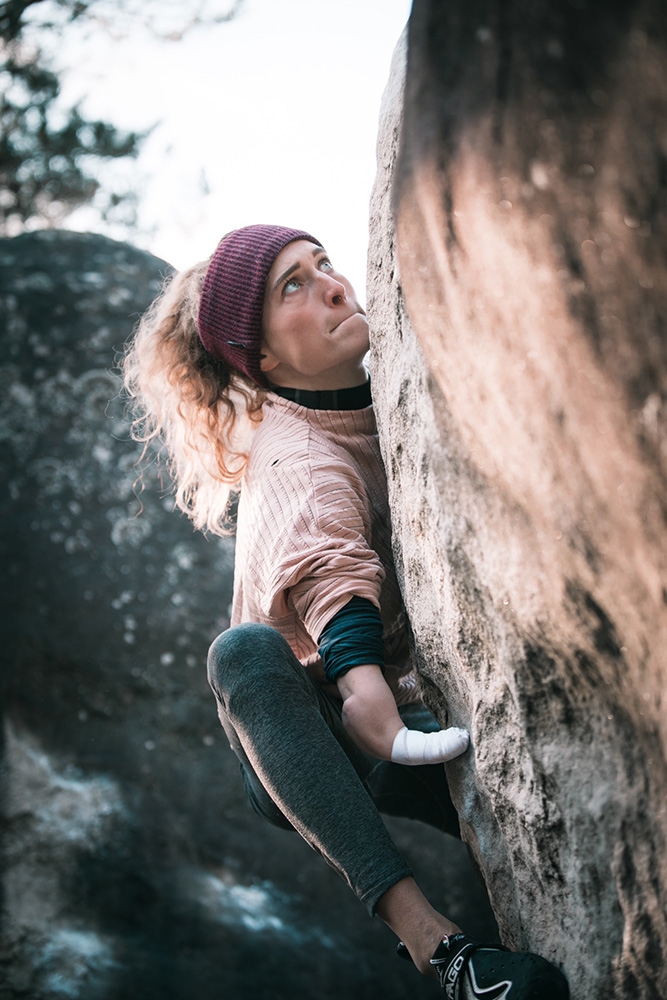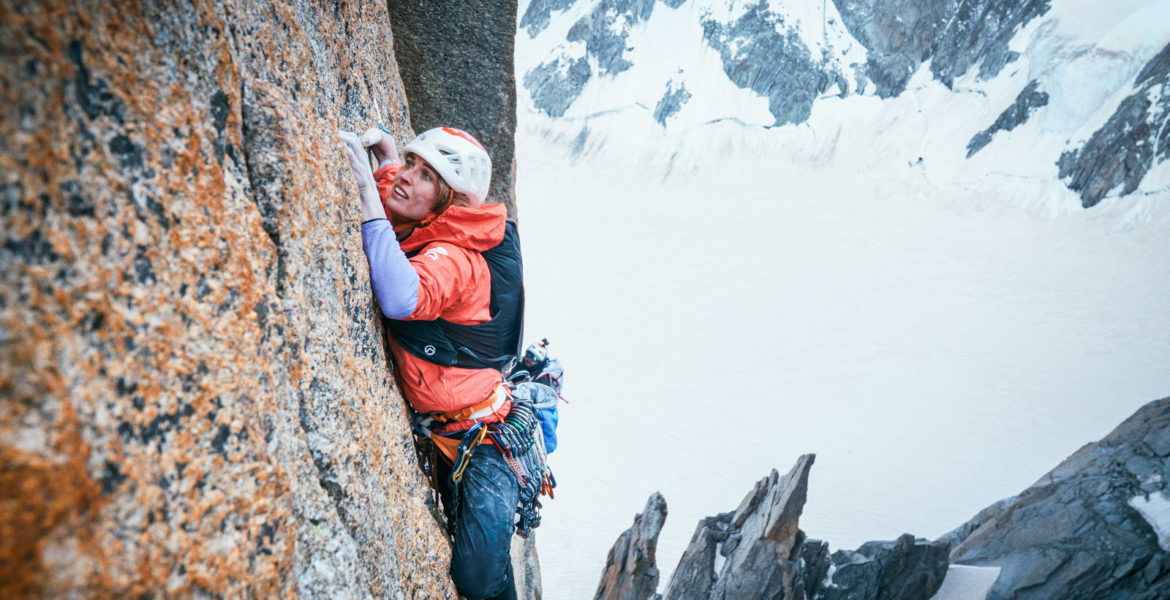Ça commence à faire beaucoup de « cap »! Cap sur El Cap, Cap ou pas cap… Les titres des films de grimpe francophones frisent la monotonie. Mais enfin gageons que la polysémie sauve tout ce beau monde. Après tout, pas un de ces « caps » ne signifie la même chose. Cap-able (où se trouve peut-être une référence au « able-bodied » anglo-saxon, lequel désigne les gens en situation de handi-cap?), Cap Horn, Cap-ucin, El Cap-itan, Cap-tain à la belle cap-e.
Et puis en y réfléchissant davantage, on se rend compte qu’il existe une certaine filiation entre ces deux films. Une grande-voie, et dans les deux cas des handicaps qui, finalement, n’en sont pas tant que ça. Seb Berthe et ses sbires s’étaient astreints à rallier le Yosemite en voilier puis par la route, pas l’entreprise la plus simple (à beaucoup de niveaux, dont logistique) ni la plus expéditive pour grimper une stone, même big. Solenne Piret, elle, est née sans avant-bras ni main à droite; a priori, cela ne la prédestinait donc pas le plus directement à se lancer dans l’escalade, a fortiori dans une grande-voie alpine de trad.
Cap ou pas cap est à ranger sur l’étagère des beaux films. La séquence d’ouverture est magnifique, avec un « travelling » à ras de neige vers le Grand Capucin, puis un gros plan sur l’océan de roche jaune-orange-rouge et les fissures de la « Voie des Suisses », honneur au minéral, accompagné par le souffle laborieux de Solenne, qui finit par apparaitre dans le champ. Ça sent bon l’effort, l’altitude, l’isolement, et quand même sacrément la magnificence du lieu.
Le réalisateur Jérôme Tanon a bellement jugé son oeuvre, qui résume la vie d’une femme sans main droite à la façon dont on s’imagine que la principale intéressée la sent en son for intérieur: circulez, y’a rien à voir. Oui je suis née sans, voilà, maintenant passons à ce qui compte. La première partie du film fait état de la conversion de Solenne en grimpeuse, sur fond à peu près exclusif de chutes et enchainements de blocs bellifontains dans des méthodes forcément improbables, car adaptées à un corps 3.5, non pas 4 points d’appui. Y est rappelé, excusez du peu, que Solenne Piret est également 4 fois championne du monde en para-escalade.

Les morceaux de musique bien sentis alternent avec la voie off de Solenne et les silences si bavards de la forêt ou des Alpes. Le rocher, grès ou granit, brille par son grain et ses chatoyances sous les caméras de Tanon, et cela fait autant plaisir que l’objectif de Solenne: cette grande-voie d’altitude majeure de 400m, 6b max, en tête et en trad. À une main. Et pas demain mais bien aujourd’hui, ça on le sent parfaitement dans sa respiration parfois entrecoupée de retenue, d’hésitation, de peur et de prise de courage à une main.
Non, vraiment, c’est un beau film, et qui fait chaud au coeur en ce qu’il promeut l’escalade dans une difficulté dans laquelle plus de grimpeurs peuvent se retrouver que lorsque Ondra ou Megos, Janja ou Margo font à nouveau exploser les compteurs de l’extrême. Alors attention, ceci ne prétend aucunement mettre sur une main d’égalité la prouesse de Solenne Piret avec l’ascension de la Voie des Suisses par un quidam pleinement bimane. Je n’ose imaginer le bordel que c’est de placer ses points à cinq doigts seulement, sans parler de construire son relais ou même descendre en rappel.
Enfin, si de prime abord le contraste entre la première moitié bleausarde et la seconde sur le Grand Capucin peut paraitre « déconnecté », je le trouve en fait particulièrement parlant lorsque l’on adopte une perspective historique. Car enfin les alpinistes parisiens des premières heures s’entrainaient pour leurs premières alpines sur les galets de Fontainebleau (ou du Peak District pour les Anglais). Comme quoi le micro et le macro peuvent danser ensemble. Les férus d’histoire auront saisi le parallèle, ceci dit il me semble que l’expliciter pour les plus jeunes ou nouveaux arrivants eut été une excellente idée. C’est ma seule « critique » de ce film de cap et d’été.
Circulez y’a tout à voir. Et pour ça, il faudra vous rendre à une projection de Montagne en scène.
Texte : Denis Lejeune – Photos de Arthur Delicque et Hugo Clouzeau
That’s a lot of ‘cap’! Cap sur El Cap, Cap ou pas cap… The titles of French-language climbing films seem border on monotony these days. But let’s hope that polysemy saves the day. After all, none of these ‘caps’ mean the same thing. Cap-able (perhaps a reference to the Anglo-Saxon ‘able-bodied’?), Cap Horn, Cap-ucin, El Cap-itan, Cap-tain with a flowing cap-e.
And then, on further reflection, one realises there is a certain connection between these two films. A long route, and in both cases disabilities that, in the end, are not so much of a handicap. Seb Berthe and his henchmen had set themselves the task of reaching Yosemite by sailboat and then by road, not the easiest undertaking (on many levels, including logistics-wise) nor the quickest way to climb a stone, even a big one. Solenne Piret was born without a right forearm or hand, which, at first glance, did not seem to predestine her to take up climbing, let alone a long alpine trad route.
Cap ou pas cap belongs on the shelf with the great films. The opening sequence is sublime, with a tracking shot across the snow towards the Grand Capucin, followed by a close-up of the sea of yellow-orange-red rock and the cracks in the ‘Swiss route’, paying homage to the mineral, accompanied by Solenne’s laboured breathing, who eventually appears in the frame. It conveys the effort, the altitude, the isolation, and yet the sheer magnificence of the place.
Director Jérôme Tanon has beautifully judged his work, which sums up the life of a woman without a right hand in the way we imagine she feels it deep down: move along, there’s nothing to see here. Yes, I was born without it, now let’s move on to what matters. The first part of the film recounts Solenne’s conversion to climbing, against a backdrop of almost exclusively falls and sequences of Bellifontaine boulders using methods that are inevitably improbable, as they are adapted to a body with 3.5 points of support, not 4. It is worth noting that Solenne Piret is also a four-time world champion in para-climbing.
The well-chosen pieces of music alternate with Solenne’s voiceover and the eloquent silences of the forest or the Alps. The rock, sandstone or granite, shines with its grain and shimmers under Tanon’s cameras, and this is as pleasing as Solenne’s goal: this major 400-metre high-altitude route, 6b max, on lead and placing pro. With one hand. And not tomorrow, but today, as we can clearly sense in her breathing, sometimes interrupted by restraint, hesitation, fear or gathering her courage with one hand.
No, really, it’s a beautiful film, and one that warms the heart in that it promotes climbing at a level of difficulty that more climbers can relate to than when Ondra or Megos, Janja or Margo once again break records at levels that are incomprehensible. Now, mind you, this is in no way intended to put Solenne Piret’s feat on a par with the ascent of the Swiss route by a fully two-handed person. There’s a world between us. I can’t imagine the mess it must be to place pro with only five fingers, not to mention building your belay or even abseiling down. That’s another kind of incomprehensible.
Finally, although at first glance the contrast between the first half in Font and the second on the Grand Capucin may seem ‘disconnected’, I actually find it particularly telling when viewed from a historical perspective. After all, the early Parisian mountaineers trained for their Alpine climb firsts on the pebbles of Fontainebleau (or the Peak District for Englishmen). It just goes to show that the micro and the macro can dance together. History buffs will have grasped the parallel, but I think it would have been a great idea to spell it out for younger viewers or newcomers. That’s my only ‘criticism’ of this film.
Come on in, there’s plenty to see. And to do that, you’ll have to go to a screening of Montagne en scène.
Text: Denis Lejeune – Pictures by Arthur Delicque and Hugo Clouzeau



